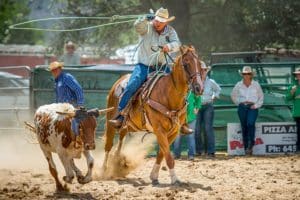Balancing Work and Rest for Horses’ Long-Term Soundness
Giving horses sufficient time to recover from athletic events could help them avoid acute injury and long-term health problems.

Training and conditioning sport horses helps prepare them both physically and mentally for competition, but the process can take a toll on their bodies. Without adequate rest, a horse’s body cannot fully recover, leading to overexertion and potentially acute injury or longterm soundness problems, increased risk of injury, and the horse becoming mentally burnt out.
Recovery activities and the amount of time a horse needs to recuperate depend on the individual horse and his workload. For example, a horse jumping a 1.60-meter (5.25-foot) course in competition needs a different recovery plan than a racehorse in training or a dressage horse competing second level.
“The recovery time (needed) is dictated by the individual horse, the type of work performed, the general health of the body, age of the horse, and so on,” says Tim Worden, PhD, an equestrian sports performance consultant based in Ontario, Canada. “In general, younger and healthier horses will recover faster than older horses or those struggling with health issues.”
How The Horse’s Body Recovers
“Following exercise, the body works to restore normal function, repair damaged structures, remove any by-products of exercise, and replenish resources such as energy,” says Worden. “Additionally, exercise stimulates different signaling pathways, which lead to proteins being assembled in the body to improve exercise tolerance (e.g., structures in muscle that can improve oxidative capacity or increase force output) for the next time the horse needs to perform a strenuous activity.”
He adds that these processes take time, and a lack of proper rest can cause overexertion in the short-term or overtraining—an imbalance between workload and recovery—in the long-term. “While allowing the horse to recover from a workout on Monday, you can still perform work on Tuesday, assuming you accommodate the fatigue level from the preceding day and steer clear of exercises that place similar demands on the body (for example, avoid doing two high-intensity jumping workouts on back-to-back days),” he says.
What Can a Horse’s Recovery Time Look Like?

and competition. | Adobe stock
Recovery can be divided into two categories: passive and active. Passive recovery involves no added physical activity, which for horses usually means spending a day turned out with no ridden exercise or groundwork, says Worden. “Active recovery is the deliberate prescription of low-to-moderate-intensity exercise to aid in the restoration of the horse’s body,” he explains. This could be going for a trail ride or a light walk, trot, and canter on a track or in a field to let the horse stretch his body.
“Recovery will vary with the type of exertion and the horse’s level of fitness,”says Steve Adair, MS, DVM, Dipl. ACVS, ACVSMR, associate professor at the University of Tennessee’s College of Veterinary Medicine, in Knoxville. “Recovery time may be a few hours between events up to a few days. Recovery time can be anything from a complete layoff to non-sport-specific exercise such as trail riding.”
“If I am building a training program, I may have one passive recovery day per week (assuming the horse can have extended turnout), but most of the time I prefer to use active recovery means,” says Worden. “Active recovery is helpful for pumping nutrients to the musculoskeletal system while simultaneously removing molecules and chemicals that accumulated during the preceding intense exercise
This story requires a subscription to The Horse magazine.
Current magazine subscribers can click here to and continue reading.
Subscribe now and gain unlimited access to premium content.
Subscribe NowWe at The Horse work to provide you with the latest and most reliable news and information on equine health, care, management, and welfare through our magazine and TheHorse.com. Our explanatory journalism provides an understandable resource on important and sometimes complex health issues. Your subscription will help The Horse continue to offer this vital resource to horse owners of all breeds, disciplines, and experience levels.

Related Articles
Stay on top of the most recent Horse Health news with

















